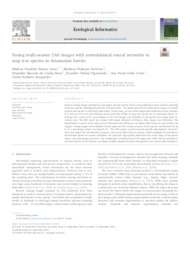Fusing multi-season UAS images with convolutional neural networks to map tree species in Amazonian forests.
Fusing multi-season UAS images with convolutional neural networks to map tree species in Amazonian forests.
Author(s): VERAS, H. F. P.; FERREIRA, M. P.; CUNHA NETO, E. M. da; FIGUEIREDO, E. O.; DALLA CORTE, A. P.; SANQUETTA, C. R.
Summary: Remote sensing images obtained by unoccupied aircraft systems (UAS) across different seasons enabled capturing of species-specific phenological patterns of tropical trees. The application of UAS multi-season images to classify tropical tree species is still poorly understood. In this study, we used RGB images from different seasons obtained by a low-cost UAS and convolutional neural networks (CNNs) to map tree species in an Amazonian forest. Individual tree crowns (ITC) were outlined in the UAS images and identified to the species level using forest inventory data. The CNN model was trained with images obtained in February, May, August, and November. The classification accuracy in the rainy season (November and February) was higher than in the dry season (May and August). Fusing images from multiple seasons improved the average accuracy of tree species classification by up to 21.1 percentage points, reaching 90.5%. The CNN model can learn species-specific phenological characteristics that impact the classification accuracy, such as leaf fall in the dry season, which highlights its potential to discriminate species in various conditions. We produced high-quality individual tree crown maps of the species using a post-processing procedure. The combination of multi-season UAS images and CNNs has the potential to map tree species in the Amazon, providing valuable insights for forest management and conservation initiatives.
Publication year: 2022
Types of publication: Journal article
Unit: Embrapa Acre
Keywords: Acre, Amazonia Occidental, Amazônia Ocidental, Bosques experimentales, Bosques tropicales, Campo Experimental, Embrapa Acre, Espécie Nativa, Experimental forests, Fenologia, Floresta Tropical, Fusão de imagens, Identificación de especies, Identificação, Imagem RGB, Imagem multitemporada, Mapeamento de espécies, Modelo CNN, Phenology, Remote sensing, Rio Branco (AC), Sensoriamento Remoto, Species identification, Teledetección, Tropical forests, Western Amazon
Observation
Some of Embrapa's publications are published as ePub files. To read them, use or download one of the following free software options to your computer or mobile device. Android: Google Play Books; IOS: iBooks; Windows and Linux: Calibre.
Access other publications
Access the Agricultural Research Database (BDPA) to consult Embrapa's full library collection and records.
Visit Embrapa Bookstore to purchase books and other publications sold by Embrapa.

